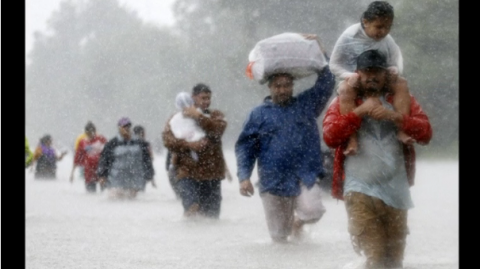
Four days after Harvey slammed onshore as a monster Category Four hurricane, turning roads to rivers in America’s fourth-largest city, emergency crews are still racing to reach hundreds of stranded people in a massive round-the-clock rescue operation.
Eager to strike a unifying tone as the country faces the first natural disaster of his presidency, Trump left the White House with his wife Melania for the disaster zone at 8:30 am (1230 GMT).
Trump has pledged the federal government’s full support as Texas makes the “long and difficult road to recovery,” insisting on the eve of his departure: “We are one American family.”
The president and first lady were not expected to visit Houston — swathes of which remain under water — making stops further west including in hard-hit Corpus Christi, which was square in the path when the hurricane made landfall.
Trump will receive briefings on relief efforts across the vast Lone Star State, where more than 8,000 people have been driven into emergency shelters and hundreds more still await rescue.
“We’re Trumponites. I trust he’s going to take care of us,” said Darla Fitzgerald, a 58-year-old nurse sheltering in a Red Cross shelter in Winnie, a town east of Houston, where the rain was lashing down very heavily on Tuesday.
“He said he would so I’m sure he’s going to.”
Ray Henrichson, a white-haired 74-year-old shelter volunteer, was equally upbeat on the president’s visit.
“I think it’s really nice that he has signed the declarations already so these people can get some help right away,” she said.
“I think it’s nice that he’s coming. He’ll probably fly around in a helicopter and see some flooded lands which we saw on the way driving here,” she said. “It is pretty dramatic.”
Levee breached
Harvey is known to have left at least three people dead so far, with six more deaths potentially tied to the storm, and officials warned the danger has far from passed.
Rising floodwaters on Tuesday breached a levee in Brazoria County south of Houston, with officials urging residents of the 50 homes in the immediate vicinity to leave immediately.
“The levee at Columbia Lakes has been breached!!” the county government tweeted on its official feed. “GET OUT NOW!!”
The US Army Corps of Engineers has already moved to open the Addicks and Barker dams — under pressure from what the agency has dubbed a “thousand-year flood event” — to prevent a catastrophe on the outskirts of Houston.
With neighboring Louisiana squarely in the storm’s path, Harvey, now a tropical storm, is pressing eastward and is expected to make landfall again late Tuesday or early Wednesday.
Residents of Louisiana’s low-lying city of New Orleans — which Tuesday marked the 12th anniversary of devastating Hurricane Katrina — are bracing for heavy rain and flash floods over the next two days.
New Orleans ‘a wild card’
“The single greatest threat continues to be the rainfall,” Dennis Feltgen, a spokesman for the Miami-based National Hurricane Center, told AFP, describing the situation as “catastrophic.”
“This is not over,” he said.
The Texas bayou and coastal prairie rapidly flooded after Harvey struck the Gulf Coast on Friday, but the region’s sprawling cities — where drainage is slower — were worst hit.
Highways were swamped and residential streets were rapidly rendered uninhabitable, with power lines cut and dams overflowing.
Already, some 50 inches (127 centimeters) of rain have fallen over Houston, sparking massive floods across the city of 2.3 million people, and its wider metropolitan area of six million.
Houston can expect two to four more inches of rain as the storm moves away, but flooded conditions will likely linger through the end of the week as the rainfall drains off, meteorologist Eric Holthaus told AFP.
In New Orleans, as of Tuesday morning, two inches of rain had already fallen over the city famous for its jazz music and Cajun cuisine — but particularly vulnerable because it lies below sea level.
“It is really sort of a wild card right now,” Holthaus said.
“There are some forecasts for up to 10 inches of rain over the next 36 hours or so for New Orleans. I would definitely not be surprised if it became more than that.”
Still a ‘life-saving’ operation
Federal officials estimate that up to half a million people in Texas will ultimately require some form of assistance — but for now the focus remains immediate disaster relief.
“This is very much still a life saving, life sustaining response effort,” a senior official with the Federal Emergency Management Agency told reporters on Tuesday.
“We still have a very active weather event under way. And that just makes the response effort all the more difficult.”
Some of the rescue efforts witnessed on the outskirts of Houston appeared to be disjointed.
In Williamstown County, a police boat sitting on a flooded highway tried to rescue people but had nowhere to take them because no vehicles could collect them from a dropoff location.
Roughly 50 people needed help, 12 of whom had non-life-threatening medical conditions, but rescuers had to leave them there despite multiple requests for emergency vehicles that never came.







